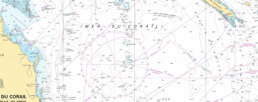New Caledonia to Australia
The passage from New Caledonia to QLD, Australia is a common route for westbound cruisers completing a South Pacific season and heading to Australia for cyclone season. Below is an overview covering route options, timing, weather patterns, entry procedures, and navigational notes.
🧭 General Passage Overview
• Route: Nouméa (New Caledonia) to Bundaberg (Queensland, Australia)
• Distance: ~820 to 900 nautical miles depending on departure and arrival points
• Direction: West-southwest
• Time at sea: 5 to 7 days for most cruising yachts (avg. speed 5-7 knots)
• Destination port of entry: Bundaberg Port Marina (Port of Bundaberg – Biosecurity and Customs clearance available)
⛵ Recommended Timing
• Best Season: Late October to mid-November
• Why: This window is after the South Pacific cruising season and before cyclone risk increases. Weather is more stable and frontal systems in the Coral Sea are less frequent.
• Avoid: December onward due to increasing cyclone activity; also avoid departing during strong SE tradewinds or when a Tasman low is active.
🌦 Weather & Routing Considerations
• Prevailing winds: SE tradewinds (10-25 knots)
• Typical pattern: Start with E-SE winds, often light near New Caledonia and building mid-passage; expect more variable winds approaching the Queensland coast.
• Troughs & Fronts: Watch for cold fronts sweeping up from the Tasman Sea. These can bring strong SW to NW winds and squalls.
• Recommended Routing Tool: Use Weather Routing plugin in OpenCPN or services like PredictWind or FastSeas. GRIB files essential.
🗺 Navigational Notes
• Departure Point: Nouméa (Port Moselle Marina) or Baie de Prony for a better jump-off
• Arrival Waypoint: Bundaberg Fairway Buoy (then follow river channel to marina)
• Hazards:
◦ Coral Sea can become rough with wind-over-current conditions.
◦ Avoid lingering in the Capricorn Channel in a strong southerly.
◦ Stay alert for commercial shipping lanes and fishing buoys closer to Australia.
🇦🇺 Arrival in Australia – Border Procedures
• Biosecurity: Australian Border Force and Biosecurity (DAFF) require advance notification.
• Notice of Arrival: Must be submitted 96 hours before ETA (Australian Border Force Yacht Arrival Info)
• Prohibited Items: Fresh produce, untreated wood, animal products, seeds, etc.
• First Port of Entry: You must check in at an official port — Bundaberg is one of the most cruiser-friendly with a smooth process and marina support.
⚓ Bundaberg Port
• Coordinates: 24°45.802′ S 152°23.426′ E
• Services:
◦ Biosecurity & customs clearance on-site
◦ Friendly staff accustomed to international arrivals
◦ Fuel, haul-out, chandlery, provisioning
• Nearby town: Bundaberg (short taxi ride) for groceries, banks, travel services
WEATHER FORECAST
Swell
















